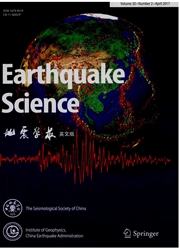

 中文摘要:
中文摘要:
Phase folding algorithms are conventionally used in periodicity analyses using X-ray astronomy pulsar.These allow for accurate identification of the cycle and phase characteristics of the physical parameters of the periodic variation. Although periodic variations in earthquake activity have long been studied, this paper is the first to apply the phase folding algorithm to the analysis of shallow(\70 km) seismic data for the period 1973–2010.The goal is to study the phase distribution characteristics of earthquake frequencies and we see a connection between earthquake occurrence and solar and lunar cycles. First, the rotation of the Sun may play a significant role in impacting on the occurrence time of earthquakes with magnitudes of less than 6.0. This may be especially pertinent for earthquakes with magnitudes between 5.0 and 6.0, when the modulation ratio reaches 12 %. The Moon’s gravity, which is generally thought to have the greatest influence on the global environment, may actually play less of a role on earthquake timing than the rotation of the Sun. Second,when we consider the world to be divided into 72 local regions based on latitude and longitude, we can see that there are more than a dozen regions with significant nonuniform distributions of earthquake occurrence time. In these regions, the ratio of v2to the number of degrees of freedom far exceeds five. As a result, we posit that some factors associated with the Sun–Earth–Moon relationship may trigger earthquake activity under certain temporal and spatial conditions.
 英文摘要:
英文摘要:
Phase folding algorithms are conventionally used in periodicity analyses using X-ray astronomy pulsar. These allow for accurate identification of the cycle and phase characteristics of the physical parameters of the periodic variation. Although periodic variations in earth- quake activity have long been studied, this paper is the first to apply the phase folding algorithm to the analysis of shallow (〈70 km) seismic data for the period 1973-2010. The goal is to study the phase distribution characteristics of earthquake frequencies and we see a connection between earthquake occurrence and solar and lunar cycles. First, the rotation of the Sun may play a significant role in impacting on the occurrence time of earthquakes with magnitudes of less than 6.0. This may be especially pertinent for earth- quakes with magnitudes between 5.0 and 6.0, when the modulation ratio reaches 12 %. The Moon's gravity, which is generally thought to have the greatest influence on the global environment, may actually play less of a role on earthquake timing than the rotation of the Sun. Second, when we consider the world to be divided into 72 local regions based on latitude and longitude, we can see that there are more than a dozen regions with significant non- uniform distributions of earthquake occurrence time. In these regions, the ratio of χ2 to the number of degrees of freedom far exceeds five. As a result, we posit that some factors associated with the Sun-Earth-Moon relationship may trigger earthquake activity under certain temporal and spatial conditions.
 同期刊论文项目
同期刊论文项目
 同项目期刊论文
同项目期刊论文
 期刊信息
期刊信息
